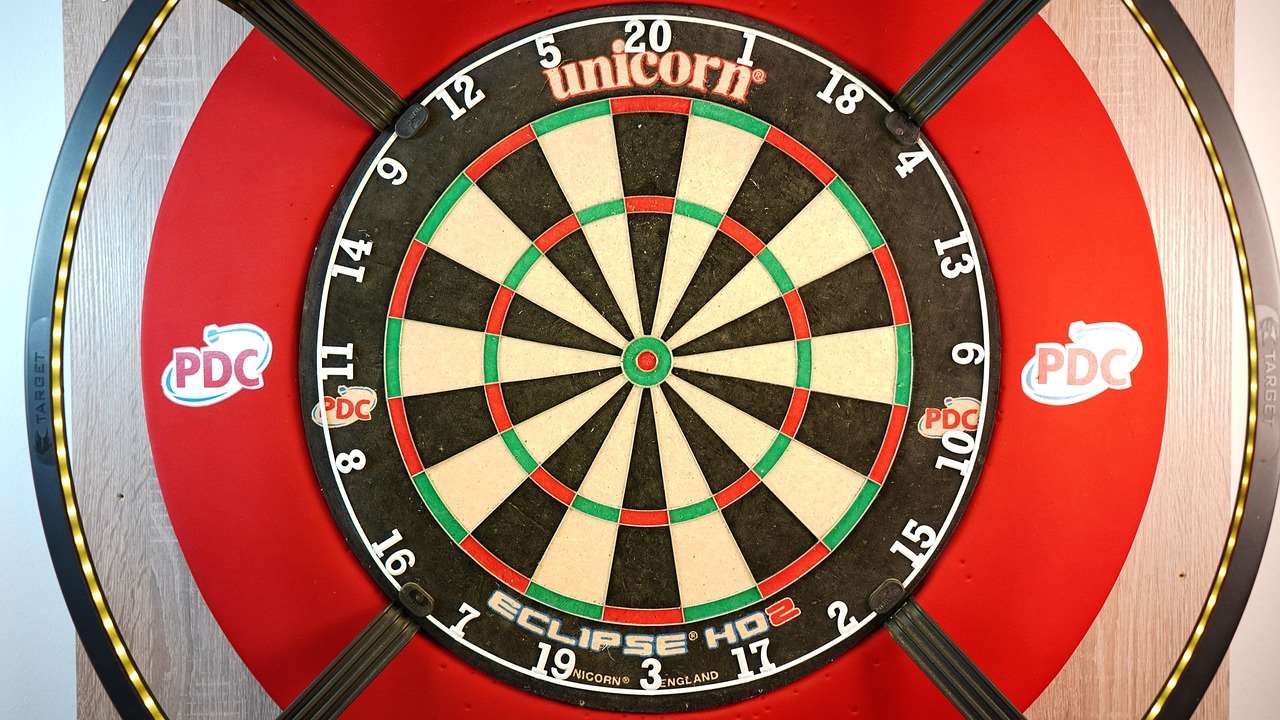Effectively communicating handicap rules clearly is crucial for ensuring fair and enjoyable competition, especially in games like darts. This article provides actionable strategies for explaining and implementing handicap systems, fostering inclusivity and preventing misunderstandings among players of varying skill levels. We’ll explore practical communication techniques, common pitfalls to avoid, and the importance of transparency in applying handicap rules.
⚠️ Still Using Pen & Paper (or a Chalkboard)?! ⚠️
Step into the future! The Dart Counter App handles all the scoring, suggests checkouts, and tracks your stats automatically. It's easier than you think!
Try the Smart Dart Counter App FREE!Ready for an upgrade? Click above!
Why is Communicating Handicap Rules Clearly So Important?
Handicap systems are designed to level the playing field, allowing players of different abilities to compete fairly. However, the effectiveness of any handicap system hinges on how well it’s understood and accepted by all participants. Without clear communication, even the most well-intentioned handicap system can lead to confusion, frustration, and accusations of unfairness. This can ultimately detract from the enjoyment of the game and damage team spirit, especially when modifying rules for mixed-level dart players. Therefore, taking the time to communicate handicap rules clearly is an investment in a positive and inclusive playing environment.
The benefits of **clearly explaining handicap rules** extend beyond simply avoiding arguments. When players understand the rationale behind the handicaps, they are more likely to accept them as legitimate and fair. This fosters a sense of trust and encourages players to focus on improving their own game rather than questioning the system.

Key Principles for Communicating Handicap Rules Clearly
To effectively communicate handicap rules clearly, consider these key principles:
- Simplicity: Avoid jargon and technical terms. Use plain language that everyone can understand.
- Transparency: Explain the rationale behind the handicap system and how it is calculated.
- Consistency: Apply the rules consistently across all players and games.
- Accessibility: Make the rules easily accessible to all players, both before and during the game.
- Patience: Be prepared to answer questions and address concerns.
By adhering to these principles, you can minimize confusion and maximize the chances of everyone understanding and accepting the handicap system.
Breaking Down the Rules into Simple Terms
One of the biggest barriers to understanding handicap rules is often the use of complex terminology or convoluted explanations. Strive to simplify the rules as much as possible. For example, instead of saying “Each player’s handicap will be calculated based on their average score over the past five games,” you could say “We’ll look at your scores from the last five games to figure out your handicap.”
Use analogies or real-world examples to illustrate how the handicap system works. If you’re using a point-based handicap system, you could explain it as similar to giving someone a head start in a race. The key is to make the explanation relatable and easy to grasp, which is important when adapting darts rules for beginners.
Visual Aids: Charts, Diagrams, and Examples
Visual aids can be incredibly helpful in communicating complex information. Consider creating a chart or diagram that visually represents how the handicap system works. This can be particularly useful for explaining calculations or showing how different handicaps affect the game. Providing concrete examples of how the handicap system is applied in different scenarios can also help to clarify any remaining confusion.
For instance, you could create a table showing different skill levels and their corresponding handicaps. Or, you could present a series of example games with different players and their handicaps, illustrating how the final scores are adjusted to determine the winner. These visual aids can make the rules much more accessible and understandable, especially for visual learners.

Common Pitfalls to Avoid When Communicating Handicap Rules
Even with the best intentions, there are several common pitfalls that can undermine your efforts to communicate handicap rules clearly. Being aware of these pitfalls can help you avoid them and ensure that your message is received effectively.
Using Jargon and Technical Terms
As mentioned earlier, using jargon or technical terms is a surefire way to confuse players. Stick to plain language that everyone can understand. If you must use technical terms, be sure to define them clearly. For example, if you’re using the term “average,” explain exactly how it’s calculated in the context of the game. Remember, the goal is to make the rules accessible to everyone, regardless of their prior knowledge of the game.
Assuming Everyone Understands the Basics
It’s easy to assume that everyone understands the basic rules of the game, but this is not always the case. Before explaining the handicap rules, take a moment to review the basic rules of the game. This will ensure that everyone is on the same page and that no one is left behind. You could even offer a quick demonstration or explanation of the basic rules before diving into the handicap system. Consider explaining the Basic Darts Fundamentals for Beginners to new players.
Failing to Provide Examples
Abstract explanations can be difficult to grasp, especially when dealing with numbers and calculations. Providing concrete examples is crucial for helping players understand how the handicap system works in practice. Include examples of different scenarios and how the handicap is applied in each case. This will help players visualize the process and understand how it affects the outcome of the game.

Ensuring Transparency in Applying Handicap Rules
Transparency is key to building trust and ensuring that players accept the handicap system as fair. This means being open about how the handicaps are calculated, how they are adjusted, and how they are applied during the game. When players understand the process and feel that it is fair, they are more likely to accept the outcome, even if they don’t agree with it.
Clearly Explaining the Calculation Method
Provide a detailed explanation of how the handicaps are calculated. This should include the data that is used, the formulas that are applied, and any adjustments that are made. If the calculation method is complex, break it down into smaller, more manageable steps. Use visual aids, such as charts or diagrams, to illustrate the process. The more transparent you are about the calculation method, the more confident players will be that it is fair and accurate.
Openly Addressing Concerns and Questions
Be prepared to answer questions and address concerns about the handicap system. Encourage players to ask questions and provide clear, honest answers. If a player has a valid concern, take it seriously and address it promptly. Being open and responsive to feedback will help to build trust and ensure that players feel heard. Consider holding a Q&A session before the game to address any potential concerns.
Regularly Reviewing and Adjusting the System
Handicap systems are not static. They should be regularly reviewed and adjusted to ensure that they remain fair and accurate. This may involve updating the calculation method, adjusting the handicaps of individual players, or making changes to the rules of the game. Be transparent about these changes and explain the rationale behind them. Regularly reviewing and adjusting the system will demonstrate your commitment to fairness and ensure that the handicap system remains effective.
Practical Tips for Communicating Handicap Rules Clearly
Here are some practical tips for communicating handicap rules clearly:
- Create a written document: Provide a written document outlining the handicap rules and calculation methods. This will serve as a reference for players and ensure that everyone has access to the same information.
- Hold a meeting: Hold a meeting to explain the handicap rules and answer any questions. This will provide an opportunity for players to interact with you and clarify any confusion.
- Use visual aids: Use visual aids, such as charts, diagrams, and examples, to illustrate the handicap system.
- Be patient: Be patient and understanding when explaining the rules. Some players may need more time to understand the system than others.
- Be consistent: Apply the rules consistently across all players and games. This will help to build trust and ensure that everyone feels that the system is fair.
The Importance of Ongoing Communication
Communicating handicap rules clearly isn’t a one-time event; it’s an ongoing process. As players’ skill levels change and as the game evolves, the handicap system may need to be adjusted. It’s important to maintain open communication channels to ensure that everyone is aware of any changes and that their concerns are addressed. This could involve sending out regular updates, holding periodic meetings, or creating an online forum where players can discuss the handicap system. By fostering ongoing communication, you can ensure that the handicap system remains fair, effective, and well-understood by all participants.

Utilizing Technology for Better Communication
In today’s digital age, technology offers numerous tools for communicating handicap rules clearly and efficiently. Consider creating a dedicated webpage or app that outlines the rules, provides examples, and allows players to calculate their own handicaps. You could also use email or social media to announce updates or answer frequently asked questions. Video tutorials can be particularly effective for explaining complex calculations or demonstrating how the handicap system works in practice. By leveraging technology, you can make the rules more accessible and engaging for all players.

Conclusion: Fostering Fair Play Through Clear Communication
Communicating handicap rules clearly is essential for fostering a fair and enjoyable playing environment. By following the principles outlined in this article – simplicity, transparency, consistency, accessibility, and patience – you can minimize confusion, build trust, and ensure that everyone understands and accepts the handicap system. Remember to avoid common pitfalls such as using jargon, assuming everyone understands the basics, and failing to provide examples. Embrace ongoing communication and utilize technology to make the rules more accessible and engaging. Ultimately, by prioritizing clear communication, you can create a more inclusive and competitive environment where everyone has the opportunity to succeed. Take the time to implement these strategies and see the positive impact they have on your game and your players. You can start by examining the Fun dart game variations with modified rules.
Hi, I’m Dieter, and I created Dartcounter (Dartcounterapp.com). My motivation wasn’t being a darts expert – quite the opposite! When I first started playing, I loved the game but found keeping accurate scores and tracking stats difficult and distracting.
I figured I couldn’t be the only one struggling with this. So, I decided to build a solution: an easy-to-use application that everyone, no matter their experience level, could use to manage scoring effortlessly.
My goal for Dartcounter was simple: let the app handle the numbers – the scoring, the averages, the stats, even checkout suggestions – so players could focus purely on their throw and enjoying the game. It began as a way to solve my own beginner’s problem, and I’m thrilled it has grown into a helpful tool for the wider darts community.